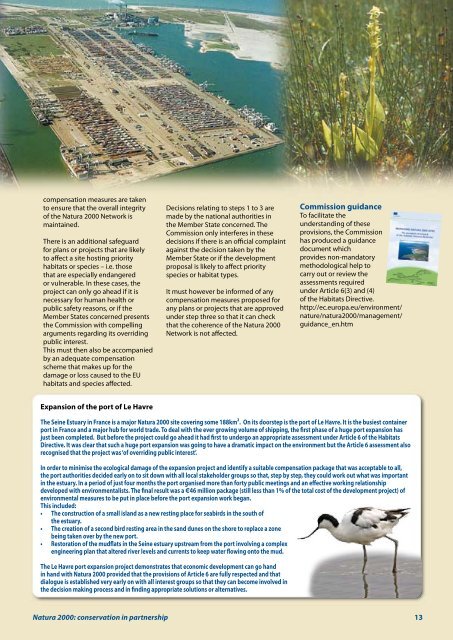00 800 6 7 8 9 10 11 - European Commission - Europa
00 800 6 7 8 9 10 11 - European Commission - Europa
00 800 6 7 8 9 10 11 - European Commission - Europa
You also want an ePaper? Increase the reach of your titles
YUMPU automatically turns print PDFs into web optimized ePapers that Google loves.
compensation measures are taken<br />
to ensure that the overall integrity<br />
of the Natura 2<strong>00</strong>0 Network is<br />
maintained.<br />
There is an additional safeguard<br />
for plans or projects that are likely<br />
to affect a site hosting priority<br />
habitats or species – i.e. those<br />
that are especially endangered<br />
or vulnerable. In these cases, the<br />
project can only go ahead if it is<br />
necessary for human health or<br />
public safety reasons, or if the<br />
Member States concerned presents<br />
the <strong>Commission</strong> with compelling<br />
arguments regarding its overriding<br />
public interest.<br />
This must then also be accompanied<br />
by an adequate compensation<br />
scheme that makes up for the<br />
damage or loss caused to the EU<br />
habitats and species affected.<br />
Decisions relating to steps 1 to 3 are<br />
made by the national authorities in<br />
the Member State concerned. The<br />
<strong>Commission</strong> only interferes in these<br />
decisions if there is an official complaint<br />
against the decision taken by the<br />
Member State or if the development<br />
proposal is likely to affect priority<br />
species or habitat types.<br />
It must however be informed of any<br />
compensation measures proposed for<br />
any plans or projects that are approved<br />
under step three so that it can check<br />
that the coherence of the Natura 2<strong>00</strong>0<br />
Network is not affected.<br />
<strong>Commission</strong> guidance<br />
To facilitate the<br />
understanding of these<br />
provisions, the <strong>Commission</strong><br />
has produced a guidance<br />
document which<br />
provides non-mandatory<br />
methodological help to<br />
carry out or review the<br />
assessments required<br />
under Article 6(3) and (4)<br />
of the Habitats Directive.<br />
http://ec.europa.eu/environment/<br />
nature/natura2<strong>00</strong>0/management/<br />
guidance_en.htm<br />
Expansion of the port of Le Havre<br />
The Seine Estuary in France is a major Natura 2<strong>00</strong>0 site covering some 188km². On its doorstep is the port of Le Havre. It is the busiest container<br />
port in France and a major hub for world trade. To deal with the ever growing volume of shipping, the first phase of a huge port expansion has<br />
just been completed. But before the project could go ahead it had first to undergo an appropriate assessment under Article 6 of the Habitats<br />
Directive. It was clear that such a huge port expansion was going to have a dramatic impact on the environment but the Article 6 assessment also<br />
recognised that the project was ‘of overriding public interest’.<br />
In order to minimise the ecological damage of the expansion project and identify a suitable compensation package that was acceptable to all,<br />
the port authorities decided early on to sit down with all local stakeholder groups so that, step by step, they could work out what was important<br />
in the estuary. In a period of just four months the port organised more than forty public meetings and an effective working relationship<br />
developed with environmentalists. The final result was a €46 million package (still less than 1% of the total cost of the development project) of<br />
environmental measures to be put in place before the port expansion work began.<br />
This included:<br />
• The construction of a small island as a new resting place for seabirds in the south of<br />
the estuary.<br />
• The creation of a second bird resting area in the sand dunes on the shore to replace a zone<br />
being taken over by the new port.<br />
• Restoration of the mudflats in the Seine estuary upstream from the port involving a complex<br />
engineering plan that altered river levels and currents to keep water flowing onto the mud.<br />
The Le Havre port expansion project demonstrates that economic development can go hand<br />
in hand with Natura 2<strong>00</strong>0 provided that the provisions of Article 6 are fully respected and that<br />
dialogue is established very early on with all interest groups so that they can become involved in<br />
the decision making process and in finding appropriate solutions or alternatives.<br />
Natura 2<strong>00</strong>0: conservation in partnership<br />
13

















